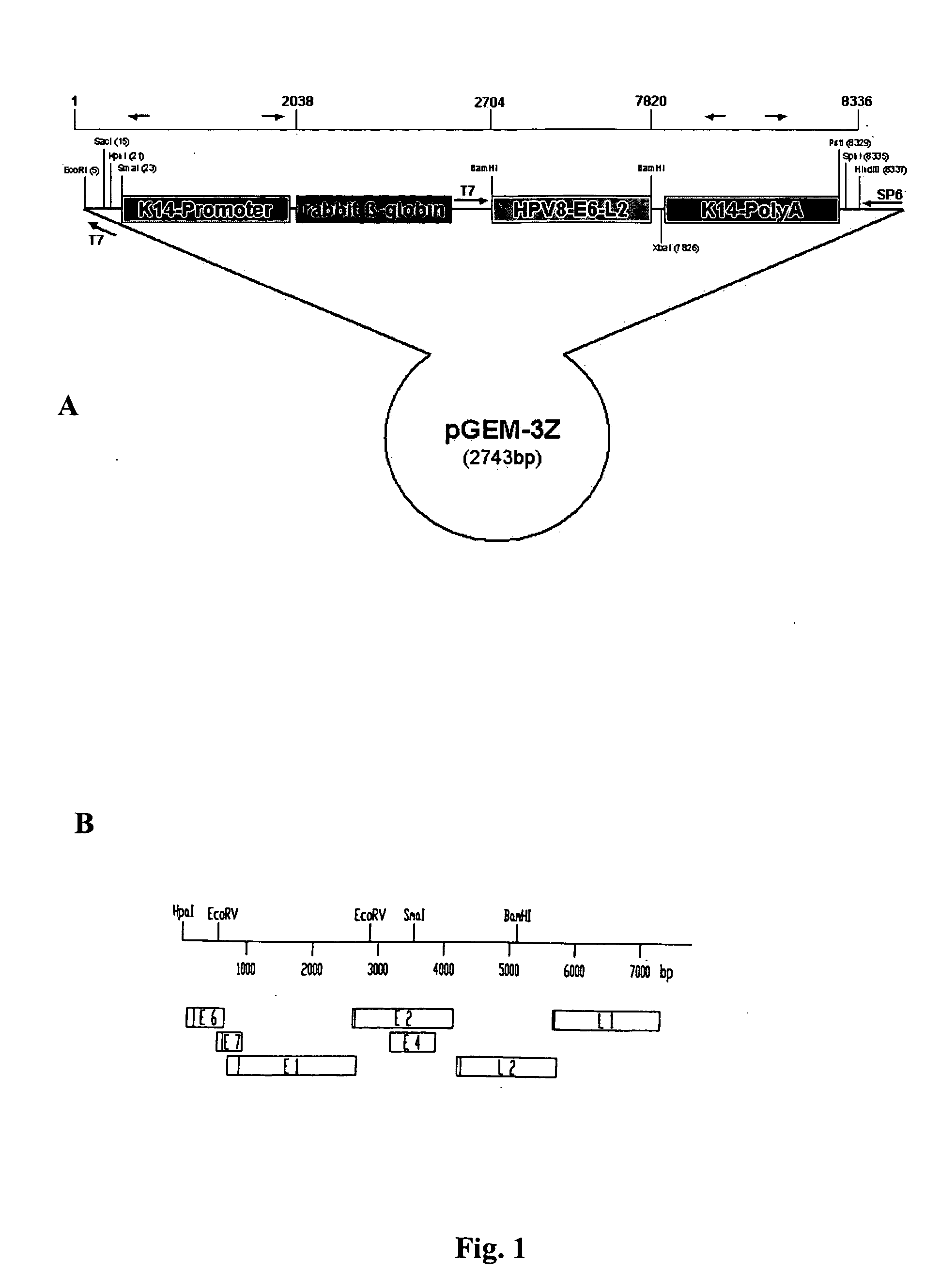Transgenic animal model for the treatment of skin tumors
a transgenic animal and tumor technology, applied in the field of nonhuman animals, can solve the problems of no definitive treatment for ev, high risk of malignant conversion, tissue at risk for repeated damage,
- Summary
- Abstract
- Description
- Claims
- Application Information
AI Technical Summary
Benefits of technology
Problems solved by technology
Method used
Image
Examples
example 1
Generation of Mice Transgenic for the Early Genes of HPV8
[0108] The early genes of HPV8 comprising the genomic region of nucleotides 1 to 5111 (Fuchs et al., J. Virol. 58, (1986) 626-634) (see SEQ ID NO: 1) were ligated into an expression vector pGEM-3Z (Promega, Madison Wis.) which additionally contained the keratin-14 promoter (SEQ ID NO: 2), the second intron of the rabbit beta-globin gene (SEQ ID NO: 3) and the keratin-14 polyadenylation signal (SEQ ID NO: 4) within one reading frame; see also Vasioukhin et al., Proc. Natl. Acad. Sci. USA 96 (1999), 8551-8556. An intron and a poyadenylation signal are advantageous for the efficient expression of the transgenic element. The HPV8 genes are under transcriptional control of the keratin-14 promoter which directs expression in basal cells of the epithelium (Vasioukhin et al., 96 (1999), 8551-8556). The vector, as shown in FIG. 1, was microinjected into into the male pronucleus of fertilized eggs of D2B6F1Crl (DBA / B16) mice using stan...
example 2
Expression of HPV8 Early Genes in Transgenic Mice
[0109] To test which of the progeny mice were expressing the HPV early genes, a PCR of the early genes E6 to E7 was performed. The following primer and amplification conditions were used:
E6 / E7 forward5′-CAA TTT TCC TAA GCA AAT GGA C-3′(SEQ ID NO: 5)E6 / E7 reverse5′-CAC TAC ATT CAG CTT CCA AAA TAC A-3′(SEQ ID NO: 6)DNA-template10 μl DNA eluate from tail clippingsprepared with the Qiamp Tissue kit (Qiagen. Hilden)according to the manufacturers intstructionsHPV8-E6 / 7 forward0.3 μMHPV8-E6 / 7 reverse0.3 μMDNTPs0.3 mM10x DNA-Polymerase buffer 5 μlTaq-Polymerase (Pharmacia)2.5 UH2Oad 50 μl
Cycling conditions: [0110] 3 min denaturing at 95° C.; [0111] 35 cycles of 45 sec at 95° C.; 1 min annealing at 50° C.; 1.5 min elongation at 72° C. [0112] final extension for 10 min at 72° C. [0113] PCR products were visualized after agarose gelelectrophoresis.
[0114] Mice developing from the microinjected eggs in foster mothers were born three weeks af...
example 3
Tumor Development in HPV8 Transgenic Mice
[0118] There were obvious differences in the occurrence of tumors in the different lines in different generations. From line 9 backcrossed with FVB / N 13 mice of the F1 generation developed tumors (52%). The average age at the beginning of tumor development was 38.6 weeks. In the F2 generation 11 mice developed tumors (57.9%). The average age at the beginning of tumor development was 17.4 weeks. In the F3 generation 14 mice developed tumors (81.6%). The average age at the beginning of tumor development was 15.5 weeks. In the F4 generation 19 mice developed tumors (70.4%). The average age at the beginning of tumor development was 12.3 weeks. In the F5 generation 6 mice developed tumors (75%). The average age at the beginning of tumor development was 7.6 weeks.
[0119] With line 9 the increase of the incidence of tumor development with proceeding generations could be demonstrated. Furthermore, the average age at the beginning of tumor developmen...
PUM
| Property | Measurement | Unit |
|---|---|---|
| Nucleic acid sequence | aaaaa | aaaaa |
Abstract
Description
Claims
Application Information
 Login to View More
Login to View More - R&D
- Intellectual Property
- Life Sciences
- Materials
- Tech Scout
- Unparalleled Data Quality
- Higher Quality Content
- 60% Fewer Hallucinations
Browse by: Latest US Patents, China's latest patents, Technical Efficacy Thesaurus, Application Domain, Technology Topic, Popular Technical Reports.
© 2025 PatSnap. All rights reserved.Legal|Privacy policy|Modern Slavery Act Transparency Statement|Sitemap|About US| Contact US: help@patsnap.com

